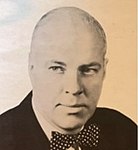Campaign
When Jenner elected to forgo a third full term in office ahead of the 1958 election, he intended his friend and protégé Governor Harold W. Handley to be his successor. With the help of Lieutenant Governor Crawford F. Parker, they hatched a plan for both Jenner and Handley to resign before the election; Parker would then become governor and appoint Handley to the vacant Senate seat. Handley's rivals within the party predicted the scheme would "set the Republican Party back an entire generation." The plan was never implemented, and Jenner served out the remainder of his term. [1]
Handley had been elected governor only two years before and had pledged during that campaign to serve the duration of his four-year term. Campaigning for the Senate was perceived as a violation of that pledge, as Handley would be forced to resign the governorship early if elected. Handley was hurt as well by another broken campaign promise, a significant tax increase he had ushered through the Indiana General Assembly. High unemployment coupled with Handley's tacit endorsement of the state right-to-work law damaged his standing with working class and union voters. [1]
Hartke, the Democratic nominee, ran a disciplined campaign that capitalized on Handley's weaknesses. On election day, he took 56.5% of the statewide vote, winning the first of three terms he would serve between 1959 and 1977. [1]



